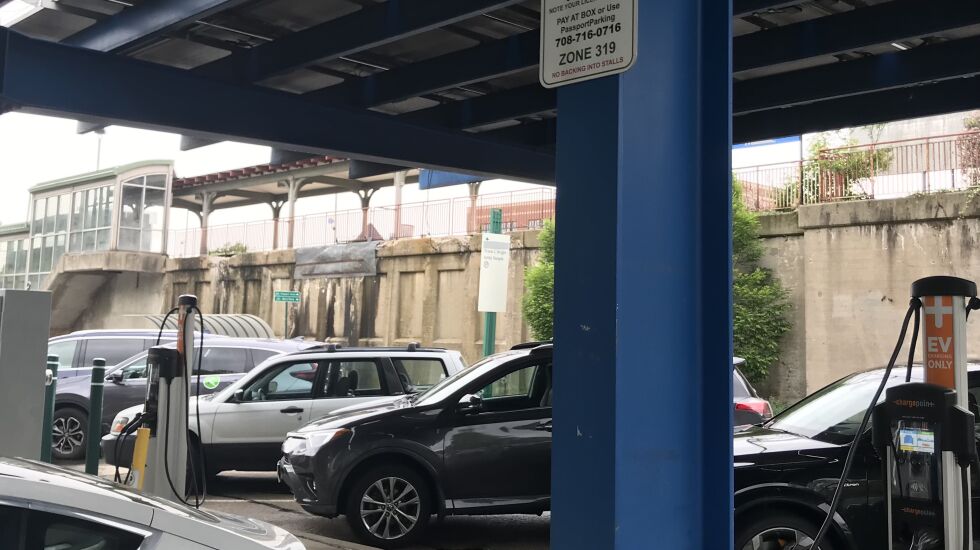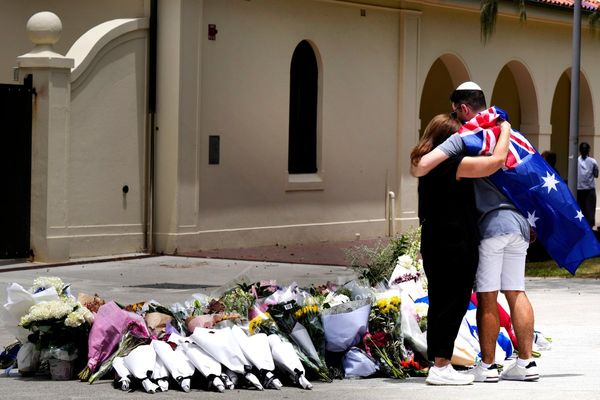
Before Bernie Powell bought his blue Tesla Model Y, he biked to electric vehicle chargers around Chicago.
He wanted to ask people about their experiences with EVs and see how accessible public chargers were from his River West condo, which does not have an EV charger.
“I went to three or four garages and then said, ‘Hey, I can do this,’” Powell said.
Since he bought his EV, Powell has relied on public stations but is trying to install a charger at his condo. Still, he said he’s been able to make it work so far.
Not everyone is so lucky.
Electric vehicles are registered in all 77 community areas in Chicago, but more than 40 of those areas have no public EV chargers, city officials say.
Often, prospective buyers express concern over an EV’s range in rural areas, where chargers may be few and far between. But the lack of public chargers shows that building out a robust network of EV chargers in densely populated urban areas like Chicago comes with its own set of challenges.

EV adoption in Illinois and Chicago raises charging network questions
State and federal legislation is ramping up the EV revolution in Illinois and across the country. In Illinois, there are more than 70,000 EVs on the road, a number set to grow substantially. In September 2021, Gov. J.B. Pritzker signed the Climate and Equitable Jobs Act, establishing the goal of adopting 1 million EVs in Illinois by 2030.
This legislation also established rebates for EV buyers and incentives for public and private organizations to install chargers.
Chicago is home to 12,267 registered electric vehicles — about 5,000 more than were registered a year ago.
But with 70% of Chicagoans living in multi-unit buildings, charger access can present challenges for EV drivers, said Samantha Bingham, the Clean Transportation Program director at the Chicago Department of Transportation. Most EV charging happens at single-family homes with private garages and driveways, said Evan Carver, a University of Chicago assistant professor of environment, geography and urbanization.
But city residents are prime candidates for EV adoption, because the average number of miles they drive daily is relatively low, Carver said.
Because of those driving patterns, Danny Freeman, a senior partner in the energy and utility division of consulting firm West Monroe, said EV range concerns are somewhat “overblown” for most Chicago residents.
Some Chicagoans struggle to find consistent charging
Powell is working to install a charger at his condo for his Tesla. He said this has brought “a lot of complications,” including cost and working with the existing infrastructure. If that effort fails, he plans to install one at his girlfriend’s house in Lake Bluff.
Ryan Freeland moved to Chicago from Los Angeles with a plug-in hybrid vehicle. When he and his wife lived in L.A., they would charge the car in their driveway. But in Chicago, they use street parking near their Lincoln Park home, where there are no nearby EV chargers.
The couple relies on public chargers, which Freeland said are often slow, broken, crowded or in inconvenient locations.
Their plug-in hybrid can run on battery power for 25 to 30 miles; the gasoline engine kicks in when the battery runs out. Freeland said the battery range would work for most city driving if they had better charger access.
“It just seems like there’s a lot more that could be done to bring Chicago a few steps further along in the process,” Freeland said.

Bingham bought an EV, but neither her apartment building nor her immediate community had EV chargers.
“Everything changed because I was driven to go places where there were chargers that I could take advantage of,” Bingham said.
This affected where she would run errands, and using public chargers cost her extra time and money. Bingham said charging at home costs about $2.50 for the equivalent of a gallon of gas, but she was paying around $4.50 at public chargers. Even at the fastest available EV chargers, Bingham would still wait 30 to 45 minutes for her car to reach an 80% charge.
About 175 of Chicago’s 850-plus public EV charging stations belong to Tesla. For now, Tesla chargers work only on Tesla vehicles, but that should soon change.
In February, the White House announced that Tesla will open at least 7,500 new and existing chargers for public use by the end of 2024.
The announcement is part of a larger effort by the Biden administration to encourage EV adoption. In November 2021, Biden signed the Bipartisan Infrastructure Law, which included rebates for EV buyers and federal dollars for building chargers along interstate highways.
Chargers in cities and chargers in residential buildings, however, are not eligible for this National Electric Vehicle Infrastructure formula funding.
Startups, politicians seek EV charging solutions
Diallo Powell, co-founder and CEO of Stak Mobility, said he hopes to open charging stations in residential, retail and multi-use developments in Cook County.
Powell said Stak tries to address space constraints on charging in cities by building multi-level charging carousels. Motorists drive into a parking spot at ground-level. After the driver gets out, the carousel — which works more like a Ferris wheel, actually — moves the car up to an open charging spot up to 60 feet in the air.

He plans to have two carousels up and running within the next few months — one in Gainesville, Florida, and one in Pittsburgh. In Gainesville, Powell said the Stak carousel created 26 charging spaces on the footprint of four traditional parking spaces.
“People are still tied to their cars as a primary mode of transport, and I think in areas like that and a lot of secondary cities ... we could be really instrumental in supporting the transition to electric vehicles,” Powell said.
State Sen. Sara Feigenholtz (D-Chicago) has seen the challenges of urban EV charging in the 6th District, which includes parts of Lincoln Park, Lake View and the Near North Side, some of the most densely populated neighborhoods in the city. This district also includes some of the ZIP codes with the most EVs in Chicago, according to state data.
Feigenholtz sponsored Senate Bill 40, which passed both houses on May 4. If signed into law, the bill would require all new single-family homes and all new and renovated multi-unit residential buildings in Illinois to include EV-capable parking spaces.

Access issues, transportation concerns persist
Lack of access to chargers is not just a problem in Feigenholtz’s district. In fact, the South and West sides of Chicago are home to even fewer public charging stations, making EV adoption in these areas less feasible.
“When you look at where the distribution of EV chargers are, they tend to be in the wealthier communities,” said Freeman, the consultant. “That’s still something that needs to be addressed,” he added, especially given the savings that EVs could offer lower-income Chicagoans.
Carver said the emissions reductions brought by widespread EV adoption are something the city “should strive for.”
Nevertheless, he does not think EVs are the ultimate solution to the city’s desire to fight climate change or improve mobility. Even if everyone in Chicago started driving an EV, the city would still face problems of congestion, traffic fatalities and street maintenance.
“I really want cities to ask themselves whether they want to go all in on EVs,” Carver said, “or whether they want to have a more comprehensive mobility policy that includes transit, includes walkability, includes bikeability.”








